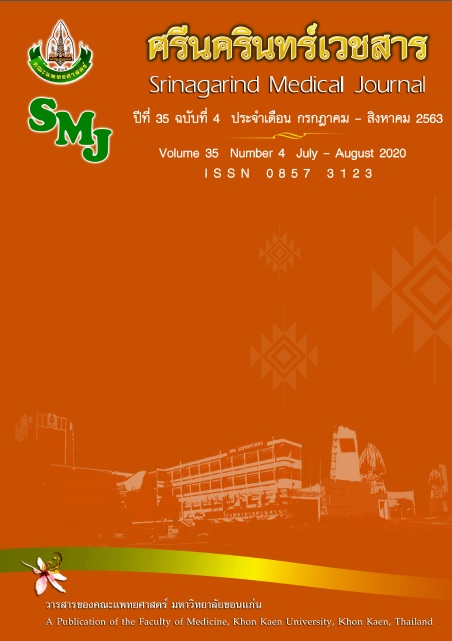Mortality and Predictive Factors in Pediatric Severe Sepsis and Septic Shock after Implementation of Surviving Sepsis Campaign Guideline in Srinagarind Hospital
Abstract
อัตราการเสียชีวิตและปัจจัยที่เกี่ยวข้องหลังใช้แนวทางการรักษาภาวะติดเชื้อรุนแรงในกระแสโลหิต และภาวะช็อกจากการติดเชื้อในเด็กในโรงพยาบาลศรีนครินทร์
รัฐพล อุปลา, ชนิดา วงษ์รัตน์
ภาควิชากุมารเวชศาสตร์ คณะแพทยศาสตร์ มหาวิทยาลัยขอนแก่น
หลักการและวัตถุประสงค์: การรักษาภาวะติดเชื้อรุนแรงในกระแสโลหิตและภาวะช็อกจากการติดเชื้อในเด็ก อย่างทันท่วงที ทำให้ผู้ป่วยมีโอกาสรอดชีวิตมากขึ้น ปัจจุบันมีการใช้แนวทางการรักษาภาวะดังกล่าวในหลายสถาบัน แต่พบว่ายังไม่แพร่หลายนักในประเทศกำลังพัฒนาเนื่องจากความขาดแคลนทรัพยากรการศึกษานี้มีวัตถุประสงค์เพื่อศึกษาอัตราการเสียชีวิตและปัจจัยที่มีผลเกี่ยวข้องกับอัตราการเสียชีวิตในเด็ก ที่ได้รับการวินิจฉัยภาวะติดเชื้อรุนแรงในกระแสโลหิต และภาวะช็อกจากการติดเชื้อหลังใช้แนวทางการดูแลรักษาภาวะติดเชื้อรุนแรงในกระแสโลหิตและภาวะช็อกจากการติดเชื้อ
วิธีการศึกษา: เป็นการศึกษาแบบ Retrospective descriptive study ในผู้ป่วยเด็กทุกรายที่มีอายุตั้งแต่ 1 เดือนถึง 15 ปี ที่เข้ารับการรักษาในแผนกผู้ป่วยระยะวิกฤตเด็ก โรงพยาบาลศรีนครินทร์ โดยค้นทะเบียนข้อมูลผู้ป่วยเด็กที่ได้รับการวินิจฉัยภาวะติดเชื้อรุนแรงในกระแสโลหิตและภาวะช็อกจากการติดเชื้อในเด็ก ตั้งแต่วันที่ 1 มกราคม 2556 ถึง 31 ธันวาคม 2556 (หลังได้นำแนวทางการดูแลรักษาภาวะติดเชื้อรุนแรงในกระแสโลหิตและภาวะช็อกจากการติดเชื้อในเด็กมาใช้) เปรียบเทียบกับข้อมูลผู้ป่วย 1 ปี ย้อนหลัง
ผลการศึกษา: มีประชากรที่ได้รับการวินิจฉัยภาวะติดเชื้อรุนแรงในกระแสโลหิตและภาวะช็อกจากการติดเชื้อทั้งหมดจำนวน 30 ราย ค่ากลางอายุประชากรศึกษาอยู่ที่ 8.5 ปี โรคประจำตัวที่พบมากสุดสองอันดับ คือ โรคมะเร็งเม็ดเลือดขาว (ร้อยละ 37.9) และกลุ่มโรคทางระบบเนื้อเยื่อเกี่ยวพัน (ร้อยละ 13) หลังจากใช้แนวทางการรักษาภาวะติดเชื้อรุนแรงในกระแสโลหิตและภาวะช็อกจากการติดเชื้อในเด็ก พบว่าอัตราการเสียชีวิตลดลงเมื่อเปรียบเทียบกับข้อมูล 1 ปีย้อนหลัง อย่างมีนัยสำคัญทางสถิติ (23.3% vs 65.2% p = 0.002) และพบว่าปัจจัยที่มีความสัมพันธ์กับอัตราการเสียชีวิตอย่างมีนัยสำคัญทางสถิติคือ ภาวะ DIC (OR 10.5, 95%CI 1.06 – 103.5, p = 0.02), ScvO2 น้อยกว่า 70% (OR 16.5, 95% CI 1.0 - 250.1, p = 0.02 ) และระดับ lactate ที่มากกว่า 4 mmol/L (OR 28.3, 95% CI 2.3 - 336.0, p <0.01) อัตราการเสียชีวิตที่ลดลงอาจเป็นผลจากการให้สารน้ำที่เหมาะสมให้ยาปฏิชีวนะที่รวดเร็วรวมทั้งให้ยาเพิ่มแรงบีบตัวของกล้ามเนื้อหัวใจ (inotropic agents) ที่รวดเร็วและเหมาะสม
สรุป: การใช้แนวทางการรักษาภาวะติดเชื้อรุนแรงในกระแสโลหิตและภาวะช็อกจากการติดเชื้อในเด็ก สามารถลดอัตราการเสียชีวิตในผู้ป่วยได้อย่างมีนัยสำคัญทางสถิติ ในโรงพยาบาลระดับตติยภูมิ ในประเทศกำลังพัฒนา
คำสำคัญ: ภาวะติดเชื้อรุนแรงในกระแสโลหิต; ภาวะช็อกจากการติดเชื้อ; แนวทางการรักษาภาวะติดเชื้อรุนแรงในกระแสโลหิตและภาวะช็อกจากการติดเชื้อ
Background and objective: Prompt treatment of sepsis and septic shock in pediatric patients could lead to an improved outcome. The Surviving Sepsis Campaign have been launched to guide treatments and has been followed by most contemporary centers. However, it has not been widely utilized in developing countries due to inadequate resources in multiple levels. This study aimed to investigate mortality rates and associated factors in children with severe sepsis and septic shock treated in the Pediatric Intensive Care Unit (PICU) of Srinagarind hospital, Khon Kaen university (KKU) after the implementation of the survival sepsis campaign guideline.
Method: A retrospective chart review was conducted on patients aged 1 month – 15 years treated in the PICU of Srinagarind hospital for sepsis and septic shock in 2013 after the distribution of the sepsis bundle guideline to pediatric residents. The mortality rate was compared with a historical control (Patients treated with sepsis and septic shock in 2012).
Results: Thirty patients, median aged 8.5 years (2 months – 14.5 years) were included. The two most common co-morbidities were hematologic malignancies (37.9%) and connective tissue disease (13%). After the implementation of the sepsis bundle guideline, the mortality rate has significantly decreased from 65.2% to 23.3% (p=0.002). Factors associated with increased mortality included the DIC (OR 10.5, 95%CI 1.06 – 103.5), central venous oxygen saturation (ScvO2) <70% (OR 16.5, 95% CI 1.0 - 250.1), and lactate level > 4 mmol/L (OR 28.3, 95% CI 2.3 - 336.0). Improved outcomes could potentially be explained by adequate initial fluid resuscitation, appropriate use of antibiotics, and earlier initiation of inotropic agents.
Conclusions: Implementation of the sepsis bundle guideline in a tertiary care center in developing country lead to outcome improvement. A multicenter prospective study in a larger population could better clarify its role in developing countries.
Keywords: Guideline implementation; septic shock; severe sepsis; severe sepsis resuscitation bundle; Surviving Sepsis Campaign
Introduction
Despite advancement in intensive critical care settings, sepsis and septic shock are still major causes of death in children.1-3 Early recognition of the condition and prompt initiation of initial resuscitation are critical for favorable outcomes.4-8 Most common causes of septic shock are pneumonia, intra-abdominal infection, urinary tract infection, and skin and soft tissue infection. 9-11 Septicemia could lead to septic shock and related to multi-organ failure, affecting cardiovascular, renal, pulmonary, neurological, hematological, and hepatobiliary systems.9,11
Survival Sepsis Campaign initiatives were launched to guide management and hopefully lead to outcome improvement.5 The Surviving Sepsis Campaign Bundles summarized the core concepts of the guidelines, and included recommendations on fluid therapy, obtaining blood cultures, timing of antibiotics therapy, timing of inotropic drugs therapy, central venous pressure (CVP) monitoring, documentation of superior vena cava oxygen saturation (SCVO2), and documentation of lactate levels. The areas with highest compliance were documentation of lactate levels at one-hour after the diagnosis, obtaining blood cultures before starting antibiotics, and following recommendations on IV fluid resuscitation and inotropic drugs management, while keeping SCVO2 above 70% and CVP above 8 mmHg were less successful.9,11
Several studies have evaluated the efficacy of the guidelines, however, most of them were performed in adults. For example, Shiramizo, et al., compared treatment outcomes before and after using survival sepsis campaign guidelines in adult medicine and surgery ICU during July 2005 to April 2006, found the success rate according to 6-hour and 24-hour goals improve from 6% to 13.7% and 15.1% to 44.4% respectively.9 The mortality rate was also reduced from 54% to 16.2%. In addition, Wang et al, reported a reduction in mortality rate from 44.4 to 31.6% in adult patients,12 found that mortality rate in adults from June 2008 to December 2009 decreased from 44.4% to 31.6%.12 Samransamruajkit et al evaluated the mortality rates in pediatric patients treated at King Chulalongkorn Memorial hospital from 2008 – 2012 and found the improvement from 42% to 19% after implementing Survival Sepsis Campaign.13 However, the feasibility of implementing the Survival Sepsis Campaign Guidelines in a tertiary care center far away from Bangkok, where results are inadequate in multiple levels have not been evaluated.
Here, we evaluated the mortality rate and associated factors in pediatric patients with severe sepsis and septic shock treated in the Pediatric Intensive Care Unit (PICU), Department of Pediatrics, Srinagarind hospital, Khon Kaen university, Thailand after the Survival Sepsis Campaign guidelines were utilized. The objective of this study was to study the mortality rate and associated factors of those patients after the implementation of the guidelines. We conducted a retrospective chart review on patients treated in our PICU for severe sepsis and septic shock in 2013 which we established the treatment protocol and implement guideline to all residents, and compared the mortality rate with patients treated a year prior to the implementation of the guidelines.


